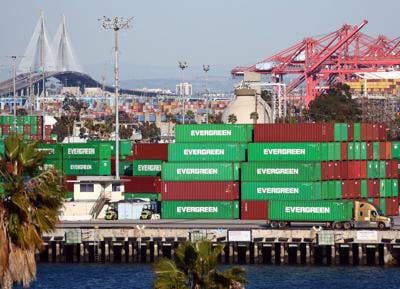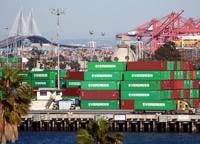
(Photo by Mario Tama/Getty Images)
California residents are raising concerns over Elon Musk’s plans to expand on Dragon spacecraft recovery operations in the West Coast, which are scheduled to be set up at the Port of Long Beach beginning next year.
The billionaire CEO had previously announced he was moving his company’s headquarters from Hawthorne, Calif., to Texas. This came as a response after Gov. Gavin Newsom signed a California law that bars schools from notifying parents if their children identify as transgender. Musk took to social media to criticize the protections, calling it “the last straw.”
However, under newly approved plans, as SpaceX moves splashdowns from off the coast of Florida to the West Coast, the company will relocate recovery operations for its Dragon spacecraft to the Port of Long Beach, establishing the site as a dedicated recovery hub.
Despite mounting concerns from local residents, SpaceX’s expansion in Long Beach has garnered strong backing from city leadership.
In May, during his annual Grow Long Beach address, Mayor Rex Richardson announced that the aerospace company had signed a new five-year lease at the Port of Long Beach. Richardson boasted that this move would increase the number of jobs and ultimately spur economic growth.
But local community members have mobilized in opposition, citing both environmental and political concerns. On April 22, there was an Earth Day sit-in at the Long Beach City Council to rally locals against the potential contamination that the aerospace company would contribute to.
Although the full environmental impact of SpaceX’s growing presence remains to be determined, the company has a history of disregarding environmental regulations.
In August 2024, the Texas Commission on Environmental Quality cited SpaceX for illegally discharging pollutants into or near state waterways. Similarly, the Environmental Protection Agency (EPA) charged Musk $148,378 in fines for damaging protected wetlands and releasing wastewater without permits.
Investigative records suggest the more recent infractions reflect a pattern, raising concerns about how the company will manage its growing footprint in Southern California.
Ben Harris, Senior Staff Attorney for Regulatory Affairs and Legal Policy at Los Angeles Waterkeeper, told CALÓ News that while it is difficult to predict the exact environmental impact of the spacecraft recovery operations, there is still a likelihood that it will pose a risk to local ecosystems.
“We [Los Angeles Waterkeeper] would be concerned about perpetuating air quality and water quality impacts in the Long Beach area, which includes several disadvantaged communities already facing high pollution burdens,” said Harris in a statement.
While spacecraft and recovery equipment have the potential to introduce pollutants into the marine environment, Harris notes that there is no clear way to determine whether alternative uses of the site would pose a greater or lesser environmental risk. Should spacecraft recovery become a regular activity in the area, he argues, the site warrants ongoing environmental monitoring.
Environmental advocates have historically leveraged the law in protecting natural resources and habitats. “We have some pretty robust environmental laws in California that are insulated from the federal government,” Harris explained, pointing to the state’s Porter-Cologne Water Quality Control Act, which predates and complements the federal Clean Water Act. “It gives local regulators—like the Los Angeles Regional Water Board—the authority to control pollution and new sources of pollution, covering everything you’d expect under the Clean Water Act.”
But enforcement isn’t always in the public’s hands. “That’s one of the laws that citizen groups cannot really enforce,” Harris states. “We can advocate and urge local governments to act, but we can’t sue polluters directly under that law. For that, we turn to the federal Clean Water Act, which does allow for citizen supervision.”
Another avenue for oversight, however, is the California Environmental Quality Act (CEQA), which requires environmental review of projects endorsed or permitted by public agencies. “CEQA is a tool to ensure adequate environmental review for any project that may significantly impact the environment,” they said. “It only kicks in when there’s a discretionary government action involved—like a permit or approval.”
Still, as SpaceX’s expansion continues to advance, several key environmental policies will serve as vital avenues for public oversight and accountability as recovery operations take shape along the West Coast.











(0) comments
Welcome to the discussion.
Log In
Keep it Clean. Please avoid obscene, vulgar, lewd, racist or sexually-oriented language.
PLEASE TURN OFF YOUR CAPS LOCK.
Don't Threaten. Threats of harming another person will not be tolerated.
Be Truthful. Don't knowingly lie about anyone or anything.
Be Nice. No racism, sexism or any sort of -ism that is degrading to another person.
Be Proactive. Use the 'Report' link on each comment to let us know of abusive posts.
Share with Us. We'd love to hear eyewitness accounts, the history behind an article.